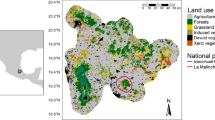Abstract
The effect of the microclimate on the daily abundances of flying dipterans and the responses of the insects within their boundary layers have been assessed using suction traps and computer linked micro-meteorological outstations in a field experiment in northern England. Daily abundances of each family are very dependent upon the vagaries of the weather, and different families respond differently to the measured conditions; the temperature is most important for afternoon-flying families but for dusk- and night-flying families the wind speed is important, as are the climatic conditions earlier in the day. Small-bodied insects are much more sensitive to wind than are big-bodied insects. The results suggest that factors other than the measured physical ones are important in determining the distribution of flying Diptera within their boundary layers.
Similar content being viewed by others
References
Baker TC, Roelofs WL (1981) Initiation and termination of oriental fruit moth male response to pheromone concentration in the field. Envir Entomol 10:211–218
Barnes HF (1925) The ecological distribution of adult crane-flies in Carnarvonshire. J Ecol 13:138–148
Bess HA (1974)Hedylepta blackburni, a perennial pest of coconut on wind-swept sites ofValsa leucostoma. Phytopathology 66:987–991
Boiteau G, Bradley JJR, Van Duyn JW (1979) Bean leaf beetle: flight and dispersal behaviour. Ann Entomol Soc Am 72:298–302
Brantjes NBM (1981) Wind as a factor influencing flower-visiting byHadena bicruris andDeilephila elpenor. Ecol Entomol 6:361–363
Colyer CN, Hammond CO (1968) Flies of the British Isles. Warne, London New York
Disney RHL (1980) Records of flower-visiting by scuttle flies (Diptera, Phoridae) in the British Isles. Naturalist Hull 105:45–50
Downes JA (1955) Observations on the swarming flight and mating of Culicoides (Diptera, Ceratopogonidae). Trans R Entomol Soc Lond 106:213–235
Duelli P (1980) Adaptive dispersal and appetitive flight in the green lacewing,Chysopa Cornea. Ecol Entomol 5:213–220
Gillies MT, Wilkes TJ (1972) The range of attraction of animal baits and carbon dioxide for mosquitoes. Studies in the freshwater area of West Africa. Bull Entomol Res 61:389–404
Gillies MT, Wilkes TJ (1981) Field experiment with a wind tunnel on the flight speed of some West African mosquitoes (Dip.: Culicidae). Bull Entomol Res 71:65–70
Hawkes HA (1961) Fluctuations in the aerial density ofAnisopus fenestralis Scop. (Diptera) above sewage bacteria beds. Ann Appl Biol 49:66–76
Inscoe M (1977) Chemical communication in insects. J Washington Acad Sci 67:16–33
Johnson CG (1969) Migration and dispersal of insects by flight. Methuen, London
Kennedy JS (1977) Olfactory response to distant plants and other odour sources. In: Shorey HH, McKelvey J (eds) J Chemical control of insect behaviour, chapt 5
Khalsa HG (1948) Biology ofAnisopus fenestralis Scop., a new invader of sewage filter beds at Knostrop, Leeds. Thesis, Leeds University
Kidd LN, Brindle A (1959) The Diptera of Lancashire and Cheshire. Buncle, Cheshire
Lewis T (1966) An analysis of components of wind affecting the accumulation of flying insects near artificial windbreaks. Ann Appl Biol 58:365–370
Lewis T (1967) The horizontal and vertical distribution of flying insects near artificial windbreaks. Ann Appl Biol 60:23–31
Peng RK (1991) The influence of microclimate on the spatial distribution of flying insects. PhD Thesis, University of Leeds
Peng RK, Sutton SL, Fletcher CR (1992) Spatial and temporal distribution patterns of flying Diptera. J Zool, in press
Pinchin RD, Anderson J (1936) On the nocturnal activity of Tipulidae (Diptera) as measured by a light trap, (1) The time of flight and proportion of sexes. Proc R Entomol Soc Lond 11:69–75
Robertson AG (1939) The nocturnal activity of crane-flies (Tipulidae) as indicated by captures in a light trap at Rothamsted. J Anim Ecol 8:300–322
SAS Institute Incorporated (1985) SAS User's Guide. Statistics, version 5 edition. Cary, North Carolina
Skidmore P (1985) The biology of the Muscidae of the world. Junk, Dordrecht
Stubbs A, Chandler P (1978) A dipterist's handbook. Kingprint, Richmond, Surrey
Taylor LR (1960) The distribution of insects at low level in the air. J Anim Ecol 29:45–63
Taylor LR (1962) The absolute efficiency of insect suction traps. Ann Appl Biol 50:405–421
Taylor LR (1963) Analysis of the effect of temperature on insects in flight. J Anim Ecol 32:99–117
Taylor LR (1974) Insects migration, flight periodicity and the boundary layer. J Anim Ecol 43:225–238
Vale GA (1977) The flight of tsetse flies (Dip.: Glossinidae) to and from a stationary ox. Bull Entomol Res 67:297–303
Williams CB (1940) An analysis of four year captures of insects in a light trap. Part II. The effect of weather conditions on insect activity; and the estimation and forecasting of changes in the insect population. Trans R Entomol Soc Lond 90:227–306
Williams CB (1951) Changes in the insect populations in the field in relation to preceding weather conditions. Proc R Soc Lond B 138:130–156
Willmer PG (1982a) Microclimate and the environmental physiology of insects. In: Berredge MJ, Treherne JE, Wigglesworth VB (eds) Advances in insect physiology, vol 16. Academic Press, London, New York, Paris, San Diego, San Francisco, Sao Poulo, Sydney, Tokyo, Toronto, pp 1–57
Willmer PG (1982b) Hygrothermal determinants of insect activity patterns: the Diptera of water lily leaves. Ecol Entomol 7:221–231
Willmer PG (1983) Thermal constraints on activity patterns in nectar-feeding insects. Ecol Entomol 8:455–469
Author information
Authors and Affiliations
Rights and permissions
About this article
Cite this article
Peng, R.K., Fletcher, C.R. & Sutton, S.L. The effect of microclimate on flying dipterans. Int J Biometeorol 36, 69–76 (1992). https://doi.org/10.1007/BF01208916
Received:
Revised:
Accepted:
Issue Date:
DOI: https://doi.org/10.1007/BF01208916




